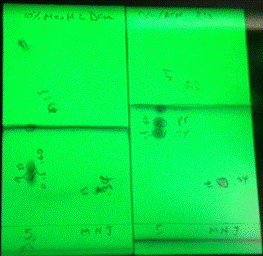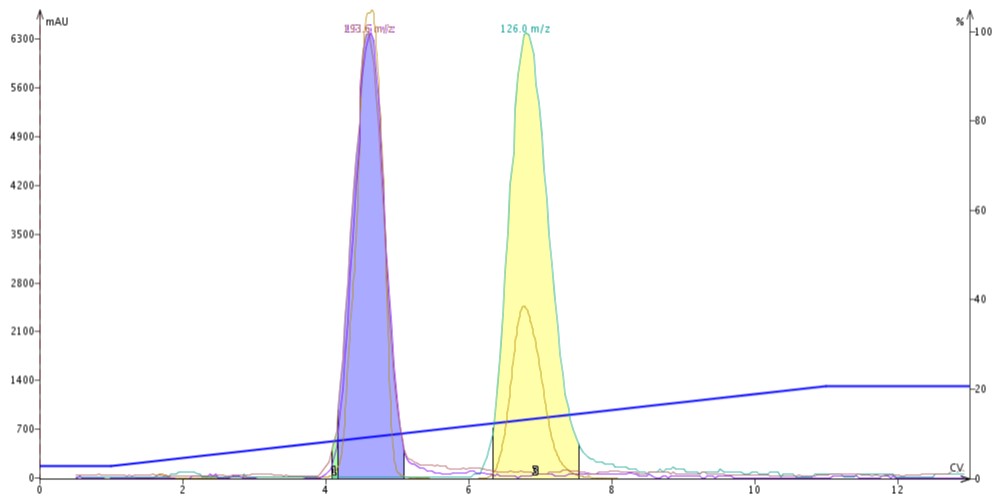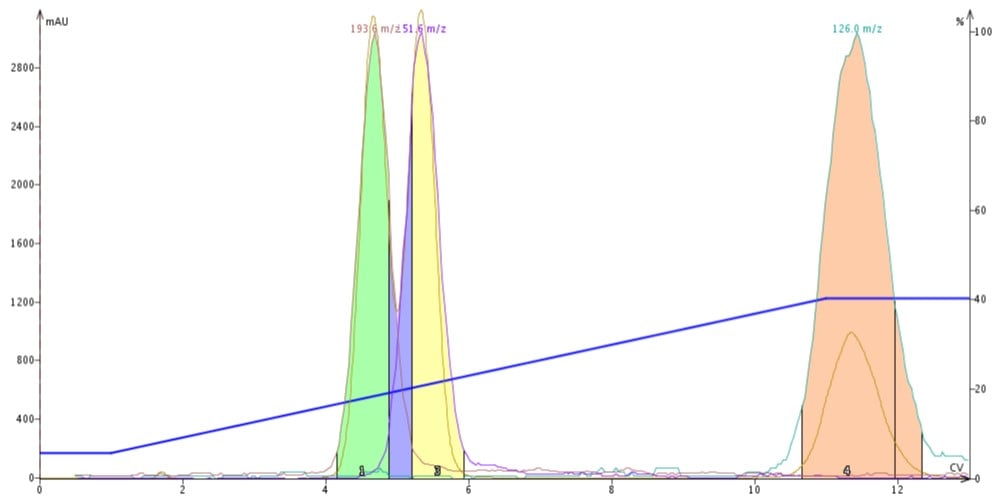When it comes to the purification of polar organic compounds many chemists turn to normal-phase flash chromatography with dichloromethane and methanol as the mobile phase. This solvent system often can be challenging to optimize due to methanol’s high polarity and protic chemistry.
I have found that acetonitrile can often replace methanol as the polar modifier in DCM-based solvent systems. In this post I will show an example where this is true.
If you have ever worked with DCM-MeOH solvent systems you are aware of the issues this solvent blend presents…
- -Difficulty in method optimization due to methanol’s strong polarity and protic nature
- -Silica instability in high methanol percentage mobile phases (a topic previously discussed)
- -Difficulty in creating shallow gradients using neat solvents (not pre-blended)
- -Inability to replicate TLC-based separations
Don’t get me wrong, I am not anti-methanol. It is a great solvent for many polar organic compounds, it's inexpensive, and available in high purity. But with acetonitrile we have a polar solvent (though not as polar as methanol) that is aprotic. These characteristics allow TLC separation data to be more effectively transferred to flash chromatography and allow the use of higher strong solvent (acetonitrile) percentages in the gradient. The benefits you can realize from using acetonitrile in place of methanol are…
- -Reliable and transferrable TLC-based methods
- -Elimination of silica instability concerns
- -Better gradient accuracy
Acetonitrile does fall in a different selectivity class (VI) than methanol (II) which means you should perform some TLC experiments to ensure you can separate your target molecule from the other compounds in the mix. You may even want to evaluate alternatives to DCM as well while you are performing your TLC if you would like to be greener or if you cannot get your target compound separated from the other components in the mixture.
To illustrate how acetonitrile can be used to successfully replace methanol in a normal-phase flash purification I chose a mixture of butyl paraben, methyl paraben, and 4-methyl-4(5)-nitroimidazole.
I performed TLC using a 10% MeOH in DCM solution on one plate and a 20% MeCN in DCM solution on the other. The ratios were set to ensure equal solvent strength (0.34).
The TLC results show that both solvent systems are capable of separating the three components but that the parabens elute faster (higher Rf values) than the imidazole, especially with the DCM/acetonitrile solvent blend. What I found interesting is that the Rf value for 4-methyl-4(5)-nitroimidazole was identical on both plates (0.34) while the parabens' Rf values were substantially different depending on the solvent, Figure 1.
 Figure 1. TLC runs comparing separation capabilities of 10% MeOH/90% DCM (left) and 20% MeCN/80% DCM (right). The two parabens are separated and better retained in the methanol-modified solvent system. The 4-methyl-4(5)-nitroimidazole compound has the same Rf value (0.34) in both solvent systems.
Figure 1. TLC runs comparing separation capabilities of 10% MeOH/90% DCM (left) and 20% MeCN/80% DCM (right). The two parabens are separated and better retained in the methanol-modified solvent system. The 4-methyl-4(5)-nitroimidazole compound has the same Rf value (0.34) in both solvent systems.
Based on the TLC data shown in Table 1, I made use of my flash system's TLC to linear gradient capability to create elution methods that should separate my three compounds using a 10 gram silica cartridge (Biotage® SNAP Ultra). I say should because the parabens, in particular, are not well resolved and have a low ΔCV which limits sample load.
| Compound | 10% MeOH/DCM | 20% MeCN/DCM | ||||
|---|---|---|---|---|---|---|
| Rf | CV | ΔCV | Rf | CV | ΔCV | |
| Butyl paraben | 0.60 | 1.67 | 0.85 | 1.18 | ||
| Methyl paraben | 0.50 | 2.00 | 0.33 | 0.74 | 1.35 | 0.17 |
| 4-methyl-4(5)-nitroimidazole | 0.34 | 2.94 | 0.94 | 0.34 | 2.94 | 1.59 |
Table 1. TLC data
As I mentioned above, one of the real challenges of using DCM-MeOH gradients is that you don't always get what TLC says you will get, even with automated TLC to gradient algorithms. In Figure 2 you can see what I mean with only two of the three compounds being separated using the TLC-based DCM/MeOH gradient.Since the sample was dissolved in methanol, I made use of Samplet® cartridges for my sample loading (eliminates the dissolution solvent effect on the separation); 150 mg was the load on the Samplet cartridges.
 Figure 2. DCM-MeOH (2-20%) gradient purification of butyl paraben, methyl paraben, and 4-methyl-4(5)-nitroimidazole. Due to methanol's strong polarity the two parabens co-elute though TLC shows a separation.
Figure 2. DCM-MeOH (2-20%) gradient purification of butyl paraben, methyl paraben, and 4-methyl-4(5)-nitroimidazole. Due to methanol's strong polarity the two parabens co-elute though TLC shows a separation.
Although the TLC shows suitable, albeit high, Rf values for the parabens (0.6 and 0.5) with 10% MeOH in DCM, they do not separate when using the TLC-based gradient (2-20% MeOH in DCM over 10 CV). The mass detector response shows total co-elution of the two parabens which really should have separated. Frustrating.
Switching to acetonitrile actually remedied the problem, Figure 3. Though the purification method used twice as much MeCN as MeOH and the TLC with MeCN-DCM eluted the parabens near the solvent front (Rf 0.85 and 0.74), the flash separation is far superior to that created with MeOH. Interestingly, the parabens eluted at about the same point in the gradient as in the DCM-MeOH gradient but they are separated, something not achieved using the DCM-MeOH gradient. Also, if you recall, 4-methyl-4(5)-nitroimidazole has the same TLC Rf values in both solvent systems but as can be seen here it is more retained in the acetonitrile-based gradient.
 Figure 3. DCM-ACN (5-40%) gradient purification of butyl paraben, methyl paraben, and 4-methyl-4(5)-nitroimidazole shows that each compound is separated even though the parabens' TLC Rf values were higher than in 10% MeOH/DCM.
Figure 3. DCM-ACN (5-40%) gradient purification of butyl paraben, methyl paraben, and 4-methyl-4(5)-nitroimidazole shows that each compound is separated even though the parabens' TLC Rf values were higher than in 10% MeOH/DCM.
So, why the differences? As mentioned earlier methanol is a protic solvent. This attribute makes it a very strong hydrogen-bonder and displacer of compounds with similar functionality (e.g. the parabens and their hydroxyl group) and compounds less polar than itself. In most purifications, compounds will elute at unpredictable volumes and may not separate if the compounds have similar polar functionality.
In the DCM-MeOH example, 4-methyl-4(5)-nitroimidazole eluted earlier than expected (should have eluted around 9-10 CV). The parabens did elute in the expected CV range but did not separate from each other!
Acetonitrile, however, is aprotic and not nearly as strong a displacing solvent as methanol. That being the case the resulting flash chromatography is more in line with TLC predictions (though all compounds are better retained than predicted) with all three molecules separated.
Have you experienced issues with DCM-methanol flash methods? Have you tried acetonitrile/DCM gradients as an alternative?
If you want to learn more about how to optimize TLC to enhance your purification, check out the blog post below:

 Organic Workflow
Organic Workflow Peptide Workflow
Peptide Workflow Scale-Up Flash Purification
Scale-Up Flash Purification  Sample Preparation
Sample Preparation Biomolecule Purification
Biomolecule Purification Oligo synthesis
Oligo synthesis Scavengers and Reagents
Scavengers and Reagents Service & Support
Service & Support Accessories & Spare parts
Accessories & Spare parts Investors
Investors Reports & News
Reports & News The Share
The Share Corporate Governance
Corporate Governance Calendar
Calendar Sustainability
Sustainability Our Offering
Our Offering Our History
Our History Our Locations
Our Locations Leadership
Leadership